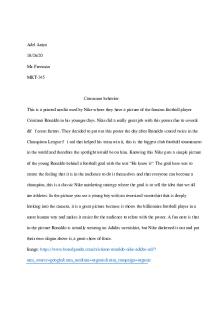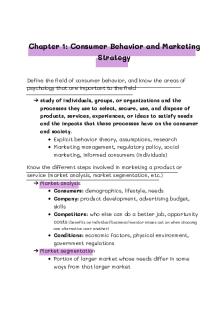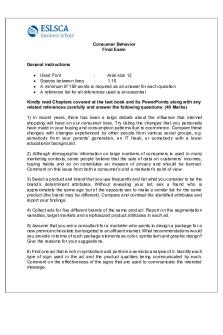Chapter 4 - Consumer Behavior PDF

| Title | Chapter 4 - Consumer Behavior |
|---|---|
| Author | James St. Patrick |
| Course | Intermediate Microeconomics |
| Institution | Wichita State University |
| Pages | 8 |
| File Size | 448.9 KB |
| File Type | |
| Total Downloads | 6 |
| Total Views | 165 |
Summary
In this chapter, we go through some exercises that explain consumer behavior and their preferences. We will notice how the amount of income the consumer has to spend to purchase a particular good affects the price of a particular good. These exercises are going to help you analyze and combine these ...
Description
Chapter 4 – Consumer Behavior 1. A consumption bundle is: a. any collection of goods that a consumer actually purchases. b. any collection of goods that the consumer is physically able to carry without assistance. c. any collection of goods affordable to the consumer. d. any collection of goods that a consumer might consider.
2. Sue's marginal rate of substitution between bananas (vertical axis) and apples (horizontal axis) is 2. That means: a. b. c. d.
Sue is willing to give up two bananas to get one more apple. Sue is willing to give up two apples to get one more banana. Sue is willing to give up half of a banana to get one more apple. Sue loves apples and hates bananas.
3. An infeasible bundle is: a. a bundle that the consumer has the ability to purchase; that is, any bundle that lies on or below the budget constraint. b. any bundle the consumer does not want. c. a bundle that the consumer cannot afford to purchase; that is, any bundle that lies below the budget constraint. d. a bundle that the consumer cannot afford to purchase; it lies to the right and above a consumer's budget constraint. 4. Choosing specific quantities of various goods to consume, given a limited budget, is an example of a(n): a. constrained-optimization problem. b. utility-maximization problem. c. cost-minimization problem. d. indifference-maximization problem. 5. Any collection of goods that a consumer might consider is called: a. a production bundle. b. an optimum consumption bundle. c. a collectable bundle. d. a consumption bundle.
6. Chris has just eaten the third slice of pizza. According to our assumptions about consumer behavior, Chris will be willing to give up ____________ orange slices for the fourth slice of pizza compared to the number of orange slices given up for the third slice of pizza. a. more b. fewer c. the same number d. an unknown number 7. Pedro is indifferent between bundle 1 (1 slice of pizza and 1 soda) and bundle 2 (1 taco and 1 glass of juice). That means: a. Pedro derives the same utility level from each of the two bundles. b. Pedro would be willing to choose between the two bundles by flipping a coin. c. Pedro's marginal utility from consuming bundle 1 is equal to his marginal utility from consuming bundle 2. d. All of the answers are correct. 8. The nearby graph shows Beau's indifference curves and budget line for pizza and tacos. At point _______the marginal utility per dollar is higher for tacos than for pizza.
Answer: “B” 9. Leslie derives satisfaction from consuming pizza (P) and tofu (T). Leslie's utility function is given by U = P0.6 T0.8. If Leslie increases her consumption of both pizza and tofu by 1%, her utility level will increase:
a. less than proportionally, i.e., less than 1%. b. It is impossible to answer this question with the information given. c. proportionally, i.e., exactly 1% d. more than proportionally, i.e., more than 1% Explanation: The sum of exponents is 1.4 10. The ___________of an indifference curve tells us the consumer's marginal rate of substitution multiplied by ?1. Answer “Slope” 11. Jo's monthly budget for shoes and purses is $200. The nearby graph shows Jo's budget constraint for purchases of shoes and purses.
The combination 2 purses and 1 pair of shoes is ________________ (feasible/infeasible) for Jo. Answer “feasible” 12. Kermit gets utility from algae (A) and houseflies (H). His utility function is U = 6A0.5 H0.5. That implies that MUA is equal to
3
( )
A 0.5 . and MUH is equal to 0.5 H
( ) 0.5
H . Kermit's budget for algae and houseflies is $40 per month. The price of algae A 0.5 is $4 per ounce and the price of houseflies is $1 apiece. Kermit's optimum monthly consumption bundle is 5 ounces of algae and ___ houseflies. 3
Answer “20”, review Chapter 4 section 4, figure it out problem.
13. Which of the following statements violates the assumption of transitivity? a. The consumer prefers bundle A to bundle B, bundle B to bundle C, bundle C to bundle D, and bundle A to bundle C. b. The consumer prefers bundle A to bundle B, bundle B to bundle C, bundle C to bundle D, and bundle C to bundle A. c. The consumer prefers bundle A to bundle B, bundle B to bundle C, bundle C to bundle D, and bundle A to bundle D. d. The consumer prefers bundle A to bundle B, bundle B to bundle C, bundle C to bundle D, and bundle B to bundle D. 14. John consumes bananas (B) and apples (A). His utility function is given by U = 3B0.5 + 2A0.5. That means bundle I (A = 2, B= 8) and bundle II (A = 1, B = 5) line on different indifference curves, and I has __________ utility than (as) II. U = 3B0.5 + 2A0.5 Bundle I: 3(8)0.5 + 2(2)0.5 = 11.30 Bundle II: 3(5)0.5 + 2(1)0.5 = 8.70 Bundle I > Bundle II. Answer “greater” or “more” 15. The nearby graph shows Jan's budget constraint for purchases of shoes and purses.
If Jan's monthly budget for shoes and purses is $100 and she buys 2 or fewer purses, the price of purses is:
a. b. c. d.
$25 per purse. $10 per purse. $50 per purse. $100 per purse.
16. Jo's monthly budget for shoes and purses is $200. The nearby graph shows Jo's budget constraint for purchases of shoes and purses.
Which of the following combinations is infeasible for Jo? a. b. c. d.
no purses and 2 pairs of shoes 2 purses and 1 pair of shoes 3 purses and 1 pair of shoes 4 purses and no shoes
17. Leslie derives satisfaction from consuming pizza (P) and tofu (T). Leslie's utility function is given by U = P0.5T0.5. If there are equal percentage increases in Leslie's consumption of pizza and tofu, Leslie's utility will increase more from the increased consumption of: a. b. c. d.
tofu. It is impossible to answer this question with the information given. pizza. equal percentage changes in tofu and pizza indicate equal increases in utility.
18. John consumes bananas (B) and apples (A). His utility function is given by U = 3B0.5 + 2A0.5. That means bundle I (A = 2, B = 8) and bundle II (A = 4, B = 4): a. b. c. d.
lie on different indifference curves, and II has greater utility than I. lie on the same indifference curve. lie on different indifference curves, and I has greater utility than II. lie on different indifference curves, and I has the same utility as II. Explanation: U = 3B0.5 + 2A0.5 Bundle I: 3(8)0.5 + 2(2)0.5 = 11.30 Bundle I: 3(4)0.5 + 2(4)0.5 = 10
19. Carin consumes bananas (B) and apples (A). Her utility function is given by U = 3B2 + 2A2. That implies that MUA = 4A and MUB = 6B. If apples are on the vertical axis and bananas are on the horizontal axis, the marginal rate of substitution at the point represented by bundle II (A = 3, B = 8) is ______. Answer “4”
20. Jo's monthly budget for shoes and purses is $200. The nearby graph shows Jo's budget constraint for purchases of shoes and purses on the blue budget constraint, and Joe's new budget constraint once the price of purses has increased on the red budget constraint.
If the price of purses has increased, the new price of purses is: a. $25 per purse. b. $50 per purse. c. $100 per purse.
d. $75 per purse. 21. Consider an indifference curve that is concave to the origin, i.e., bowed away from the origin. This indifference curve violates our assumption of: a. completeness and rankability. b. transitivity. c. the more of a particular good a consumer has, the less of something else she is willing to give up to get even more of that good, i.e., increasing Marginal Rate of Substitution. d. more is preferred to less of any good. Explanation: Transitivity allows us to rank bundles of goods consistently. 22. Consider a consumer who purchases two goods, downloadable songs (measured along the x-axis) and tablet PCs (measured along the y-axis). This consumer allocates $600 a year on purchases of these two goods. If the price of each song is $3 per unit and the price of tablet PCs is $400 per unit, what is the slope of the consumer's budget line? a. b. c. d.
-400/600 -3/400 -3/600 -400/3
23. The nearby graph shows Jo's budget constraint for purchases of shoes and purses.
If Jo's monthly budget for shoes and purses is $200, the price of shoes is: a. $50 per pair. b. $75 per pair. c. $100 per pair. d. $200 per pair. 24. Because consumers value variety, we assume that: a. his preferences exhibit increasing marginal utility. b. the more of a particular good a consumer has, the more she is willing to give up of something else to get even more of that good. c. the less of a particular good a consumer has, the less of something else she is willing to give up to get even more of that good. d. the more of a particular good a consumer has, the less of something else she is willing to give up to get even more of that good....
Similar Free PDFs

Chapter 4 - Consumer Behavior
- 8 Pages

Consumer behavior
- 5 Pages

Consumer Behavior
- 33 Pages

Lecture 6 Consumer Behavior
- 2 Pages

Consumer Behavior Final Exam
- 2 Pages

Consumer credit chapter 4
- 7 Pages

MCQs-Consumer-Behavior
- 24 Pages

Consumer Behavior quiz
- 1 Pages

Case Study Consumer Behavior
- 3 Pages

Jada May - consumer behavior
- 5 Pages

Consumer behavior séance 2
- 5 Pages

2 Symbolic Consumer Behavior
- 11 Pages

Readings Summary - Consumer Behavior
- 62 Pages
Popular Institutions
- Tinajero National High School - Annex
- Politeknik Caltex Riau
- Yokohama City University
- SGT University
- University of Al-Qadisiyah
- Divine Word College of Vigan
- Techniek College Rotterdam
- Universidade de Santiago
- Universiti Teknologi MARA Cawangan Johor Kampus Pasir Gudang
- Poltekkes Kemenkes Yogyakarta
- Baguio City National High School
- Colegio san marcos
- preparatoria uno
- Centro de Bachillerato Tecnológico Industrial y de Servicios No. 107
- Dalian Maritime University
- Quang Trung Secondary School
- Colegio Tecnológico en Informática
- Corporación Regional de Educación Superior
- Grupo CEDVA
- Dar Al Uloom University
- Centro de Estudios Preuniversitarios de la Universidad Nacional de Ingeniería
- 上智大学
- Aakash International School, Nuna Majara
- San Felipe Neri Catholic School
- Kang Chiao International School - New Taipei City
- Misamis Occidental National High School
- Institución Educativa Escuela Normal Juan Ladrilleros
- Kolehiyo ng Pantukan
- Batanes State College
- Instituto Continental
- Sekolah Menengah Kejuruan Kesehatan Kaltara (Tarakan)
- Colegio de La Inmaculada Concepcion - Cebu


